If you’d like to have your own Kegerator to dispense draft beer in your home, all it takes it a video camera and enough creativity to be the next George Lucas or Martin Scorsese. Kegerators.com is holding a video contest with a grand prize of a kegerator. The deadline to submit your own kegerator-themed Citizen Kane is August 13 and full details can be found on the Kegerator website. Just release your inner Jackass in video form, showing just what you’d do to win a free Kegerator, upload it to YouTube or Google Video and then submit it using the online form. That’s pretty much it, though there is the requisite fine print at the bottom, but it looks like pretty standard stuff. Maybe this is how Stephen Spielberg got his big break.
Chico Estate Harvest
As Sierra Nevada Brewing puts their newest seasonal release, it’s “fresh from the field to the glass with no stops along the way.” With the third installment of Sierra Nevada’s Harvest Ale Series, they introduce a beer that is close to the brewery’s heart. Chico Estate Harvest Ale is a beer made with hops grown just feet from the brew house. They grow the hops themselves, pick them, and put them directly into the beer, still bursting with the signature flavors that have put Sierra Nevada Brewing Co. on the map. Hops this fresh can be found nowhere else.
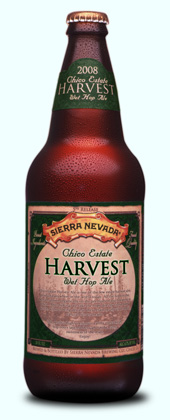
By stealing a page from the winemaker’s playbook, Chico Estate Harvest Ale will use all of the hops grown in the brewery fields for one big full-flavored Sierra Nevada beer. Typically, hops are collected and dried for use throughout the year, but as they dry, the precious oils and resins break down and some of the big flavors become muted. With Sierra Nevada’s Harvest Ale series, the brewery takes care to use the freshest hops possible, and in the case of Chico Estate and fall Harvest Ales, they use only “wet†or undried hops to add not only bitterness, but the full range of character and flavors that the small but mighty hop has to offer.
The Chico Estate Harvest Ale was originally called 20th Street Ale, and was available only on draft. At the end of August, it will be bottled for the first time under the new name.
Happy International Brewers Day
I can’t see any reason why I can’t toot my own horn here at Beer Therapy. A few months back I had this idea to start a new holiday, and today is the day. July 18 we celebrate the first International Brewers Day. If you see a brewer today, remember to give him or her a hug. Or you could just buy him a beer or drink a toast to her honor, if that’s more your style.
If you want to know more about this new holiday to honor brewers who make the great beer we all love to drink, please visit the official International Brewers Day website. Cheers!
San Francisco’s 21st Amendment Introduces New Beer Cans
Nico Freccia and Shaun O’Sullivan, the co-founders and iconic personalities behind the 21st Amendment Brewery, recently announced, “We Drink What We Can, We Can What We Drink!” The brewpub in San Francisco’s South of Market district has taken two of the pub’s beers, the award-winning, but renamed, “Hell or High Watermelon” Watermelon Wheat Beer and “Brew Free! Or Die†IPA, and dressed them up in the finest package for a beer: the can.
“Craft beer in a can? Quite CAN-didly, that’s the number one question we get around here,” says Chief Hop Head and Brewmaster O’Sullivan. “The can is actually a brilliant CAN-cept all around for craft beer,” adds Chief Watermelon Officer Freccia. “Cans are simply better for the beer–they keep it fresher by protecting it from light, they are lined so they don’t affect the flavor of the beer and they fit the craft beer drinker’s lifestyle by going places where glass just doesn’t dare—like beaches, pools, boats, parks and golf coursesâ€. And cans are better for the environment. They use less energy to produce and transport, and they are far more often recycled than glass.
Hell or High Watermelon Wheat, an American-style wheat beer made with hundreds of pounds of fresh pressed watermelon, and Brew Free! Or Die IPA, a big, hoppy beer to be reckoned with, will both be available in cans in stores and bars throughout San Francisco beginning on Tuesday, July 22nd. To celebrate, the 21st Amendment is throwing a “Can Release Party” at the legendary Toronado bar, 547 Haight St. in San Francisco at 6 p.m. on that day. The beers will be distributed by DBI Beverage in San Francisco and will also be available in limited supply throughout California with wider distribution to follow. For up to date availability, events and promotions, visit their website.
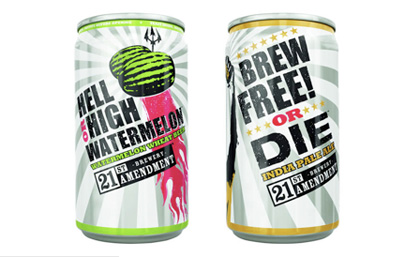
In their own words:
Who the heck are these guys? Hey, we’re Nico & Shaun. We live for great beer. In 1920, there were thousands of breweries across America making unique hand-crafted beer. The passage of Prohibition wiped out this great culture. After thirteen years without beer, the states ratified the 21st Amendment, ending Prohibition in America. At the 21st Amendment Brewery, we celebrate the right to brew beer, the freedom to be innovative, and the obligation to have fun.
Here’s to original beer…IN YOUR FACE!
American Craft Beer In Germany
On July 4th, a new American embassy opened in Berlin, Germany. Naturally, the opening was accompanied by American craft beer. A reception was held on Pariser Platz square and attended by over 4,500 guests, including former President George H. W. Bush, current German Chancellor Angela Merkel and a host of ministers from the German government.
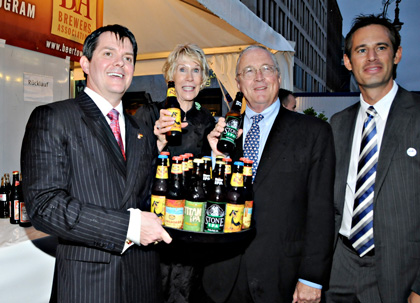
Bobby Richey, Sue Timken, Ambassador Timken, and Sam Bessinger show off American Craft Beer at the American Embassy in Berlin, Germany.
“We wanted to celebrate the return of the U.S. Embassy to its historic home in downtown Berlin in a very American way,” commented Bobby Richey, Jr., Counselor for Agricultural Affairs for the U.S. Embassy in Berlin. “We chose to serve U.S. craft beers because they embody many of the attributes typical of U.S. agricultural products: quality and innovation.” Richey contacted the Brewers Association’s Export Development Program, who provided 47 different craft beer brands from 13 American craft breweries from member breweries at the reception.
“The Brewers Association is very proud to be a part of the festivities surrounding the new opening of the German Embassy in Berlin. Exposure of American craft beer abroad actually increases demand in the U.S.,” stated Brewers Association Vice President Bob Pease. “To have our members’ products requested and sampled at the birthplace for many of the beer styles our members proudly brew today is a testament to the quality, flavor and diversity of American craft beer — which is increasingly being recognized as a world-class brand.”
InBev / A-B Press Release
InBev and Anheuser-Busch have now sent out an official press release regarding the agreement between the two brewing giants, a portion of which is listed below:
InBev and Anheuser-Busch today announced an agreement to combine the two companies, forming the world’s leading global brewer. Anheuser-Busch shareholders will receive $70 per share in cash, for an aggregate equity value of $52 billion, in an industry-transforming transaction. The combined company will be called Anheuser-Busch InBev. Both companies’ Boards of Directors have unanimously approved the transaction. InBev has fully committed financing for the purchase of all of Anheuser-Busch’s outstanding shares.
The combination of Anheuser-Busch and InBev will create the global leader in the beer industry and one of the world’s top five consumer products companies. On a pro-forma basis for 2007, the combined company would have generated global volumes of 460 million hectoliters, revenues of $36.4 billion (€26.6 billion) and EBITDA of $10.7 billion (€7.8 billion). Anheuser-Busch and InBev together believe that this transaction is in the best interests of both companies’ shareholders, consumers, employees, wholesalers, business partners and the communities they serve.
The company will make St. Louis, Missouri the headquarters for the North American region and the global home of the flagship Budweiser brand. With about 40% of the combined company’s revenues to be generated in the U.S., the company will draw on the collective expertise of Anheuser-Busch’s dedicated and experienced employees and its culture of quality. Given the limited geographical overlap between the two businesses and the efficiency of Anheuser-Busch’s brewery footprint in the United States, all of Anheuser-Busch’s U.S. breweries will remain open.
InBev CEO Carlos Brito will be chief executive officer of the combined company. The Board of Directors of the combined company will be comprised of the existing directors of the InBev Board, Anheuser-Busch President and CEO August Busch IV and one other current or former director from the Anheuser-Busch Board. In addition, the combined company’s management team will draw from key members of both InBev’s and Anheuser-Busch’s current leadership. Anheuser-Busch will become a wholly owned subsidiary of InBev upon the completion of this transaction.
The expanded company will be geographically diversified, with leading positions in the world’s top five markets – China, U.S., Russia, Brazil and Germany – and balanced exposure to developed and developing markets. A combination of Anheuser-Busch and InBev will result in significant growth opportunities from leveraging the companies’ combined brand portfolio, including the global flagship Budweiser brand and international market leaders such as Stella Artois and Beck’s, maximizing the combination’s unparalleled global distribution network and applying best practices across the new organization. Budweiser and Bud Light are the largest selling beers in the world, and the combined company will have an unmatched portfolio of imports, local premiums and local core brands.
Carlos Brito, CEO of InBev, said, “We are very pleased to announce this historic transaction today, bringing together two great companies that share a rich history of brewing traditions. We are extremely excited about the opportunities that this combination will create for consumers worldwide, as well as our shareholders, employees, business partners and wholesalers. Together, Anheuser-Busch and InBev will be able to accomplish much more than each can on its own. We have been successful business partners for quite some time, and this is the natural next step for us in an increasingly competitive global environment. This combination will create a stronger, more competitive global company with an unrivaled worldwide brand portfolio and distribution network, with great potential for growth all over the world.â€
August Busch IV, Anheuser-Busch President and CEO, stated, “Today’s announcement brings new opportunities for Anheuser-Busch and its business, brands and employees. This agreement provides additional and certain value for Anheuser-Busch shareholders, while enhancing global market access for Budweiser, one of America’s true iconic brands. We will leverage our collective strengths to create a truly diversified, global company to sustain long-term growth and profitability. In the United States and Canada, both InBev and Anheuser-Busch have seen significant benefits from our existing relationship and we look forward to replicating this success in other parts of the world.â€
Budweiser, together with Stella Artois and Beck’s, will become the combined company’s leading global brands, leveraging InBev’s expansive international footprint. InBev has a history of successfully building brands around the world, which will complement the unparalleled strength of Anheuser-Busch’s brand-building in the U.S. The two companies already have a successful U.S. distribution partnership for InBev’s European premium import brands including Stella Artois, Beck’s and Bass. Anheuser-Busch’s world-class sales and distribution system will continue to support the expansion of these brands in the U.S. market.
Anheuser-Busch’s partners fit very well with InBev’s global franchise. Anheuser-Busch has equity investments in two companies with strong brands in two key markets: Mexico’s Grupo Modelo, which owns Corona Extra, the number five brand globally; and China’s Tsingtao, the leading Chinese premium brewer. In addition, Budweiser is a strong and growing national brand in China, and the two companies’ footprints in China are complementary. InBev’s China business in southeastern China will be enhanced by Anheuser-Busch’s strength in northeastern China.
The transaction creates significant profitability potential both in terms of revenue enhancement and cost savings. The combination will yield cost synergies of at least $1.5 billion annually by 2011 phased in equally over three years. Given the highly complementary footprint of the two businesses, such synergies will largely be driven by sharing best practices, economies of scale and rationalization of overlapping corporate functions. InBev has a strong track record of delivering synergies in past transactions and is confident in its ability to achieve these synergies.
In addition, there are meaningful revenue opportunities through expansion of Budweiser on a global scale: InBev is the number one brewer in 10 markets where Budweiser has a very limited presence, and has a superior footprint in nine markets where Budweiser is already present.
The transaction is expected to be neutral to normalized earnings per-share in 2009 and accretive beginning in 2010, and return on invested capital will exceed weighted average cost of capital during the second year after close.
The transaction is subject to the approval of InBev and Anheuser-Busch shareholders, and other customary regulatory approvals. Shareholders of both companies will have an opportunity to vote on the proposed combination at special shareholder meetings that will be scheduled at a later date. InBev’s controlling shareholder has agreed to vote its shares of InBev in favor of the combination. In light of the limited overlap between the InBev and Anheuser-Busch businesses, the combination should not encounter any significant regulatory issues, and is expected to be completed by the end of 2008.
InBev has received fully committed financing with signed credit facilities from a group of leading financial institutions, including Banco Santander, Bank of Tokyo-Mitsubishi, Barclays Capital, BNP Paribas, Deutsche Bank, Fortis, ING Bank, JP Morgan, Mizuho Corporate Bank and Royal Bank of Scotland. The transaction will be financed with $45 billion in debt, including a $7 billion bridge financing for divestitures of non-core assets from both companies. In addition, InBev has received commitments for up to $9.8 billion in equity bridge financing which will allow the company flexibility in deciding upon the timing and form of equity financing for a period of up to six months after closing. The combined company is expected to retain a strong investment-grade credit profile, and rapid de-leveraging of the balance sheet is expected through strong free cash flow generation.
InBev has retained Lazard as lead advisor, JPMorgan as co-lead advisor, Deutsche Bank, and BNP Paribas as financial advisors, and Centerview Partners as industry advisor. Legal advisors are Sullivan & Cromwell, Clifford Chance, and Linklaters. Financial advisors to Anheuser-Busch are Goldman Sachs & Co., Citigroup Global Capital Markets Inc. and Moelis & Company and legal advisor is Skadden, Arps, Slate, Meagher & Flom LLP. Simpson Thacher & Bartlett LLP is legal advisor to the Anheuser-Busch Board.
Anheuser-Busch Accepts InBev’s Takeover Offer
In a Sunday afternoon vote of Anheuser-Busch’s Board of Directors, meeting at the Spirit of St. Louis airport in Chesterfield, Missouri, the $70 per share offer by InBev to acquire A-B was approved. The total sale will be nearly $50 billion and the board of directors of the newly merged company will include two Anheuser-Busch members, most likely including August A. Busch IV. The new company will be known as Anheuser-Busch InBev.
A-B Likely To Accept InBev’s Latest Offer
The AP is reporting today that Anheuser-Busch is “likely to accept a sweetened buyout offer from the Belgian-based brewer InBev SA as early as this weekend, a published report said.” On Friday, InBev upped their offer to from $65 per share to $70, a nearly 10% increase in the price. As noted by the AP story, “A deal would be a stunning turnaround from the often heated rhetoric between the two companies over the last several days.” On Friday, the news helped boost A-B’s share price to $66.50, an 8.6% rise. Juli Niemann, an analyst with the investment firm Smith Moore & Co. likewise believes an agreement will be forthcoming any time now.
“It really is all about the money,” Niemann said. “We just had to get a little bit more on the table. Bottom line is the rest is just housekeeping – what’s going to be the name of the new company, that sort of thing. The layoffs will go ahead. Asset sales – you’ve got to pay for it.”
Looking at American Craft Beer with a Japanese Tongue
With talk about the new TV show “I Survived a Japanese Gameshow†burning up the internet I couldn’t have planned a better time to discuss my recent adventures in Japan. Initially I planned on titling this article “How to get arrested in Japan without really trying†because the hot topic of our gathering of friends and family was my recent sort-of-arrest by the local beat cop. It wasn’t my fault, Ma! I was just minding my own business, sitting on a curb in Kawasaki, Japan at 6am. I was focused on my laptop screen, checking my email with a little Wi-Fi mooched from the local grade school when a shadow passed over me, hesitated, returned and cleared its throat.
Looking up, I locked eyes with a frowning policeman. “ã“ã“ã§ä½•ã‚„ã£ã¦ã‚‹ã®ã§ã™ã‹ï¼Ÿâ€ he said as my brain seized in panic. I knew what he wanted to know. Who am I? What was I up to in the wee hours of the morning, sitting on a curb with my laptop? I was a deer in the headlights. My limited grasp of the Japanese language went into hiding as I searched my brain for a response.
“Email! Email!†I blurted out as I scrambled up and turned my laptop towards him, figuring everyone knows the word email. My 6’2â€, 210lb. frame towering over him like a redwood didn’t work in my favor, and he jumped back grasping the handle of his nightstick.
Long story short, I ended up getting perp-walked back to the family home. The Neighborhood stopped what they were doing and leaned out their doorways to witness the spectacle. They whispered to one another as we passed. “We knew there was something strange about that man, always saying hello and smiling at people…I wonder who he killed? At the family home the policeman agreed to wait at the gate while I went in and woke someone to verify I was not a mass murderer. The neighbor, a woman I had viciously “good morninged” and bared my teeth at many times was talking to the policeman in hushed tones as I went in.
When I came out a few minutes later with my very sleepy sister-in-law he was gone. I guess I’d been cleared by the neighbor or some other major villain had struck in the area and drawn him away. This is how the seeds of great family stories are germinated. I am now “he-who-was-brought-home-by-the-police,” a family badge I will wear with honor as I perpetuate and expand on the story until the movie comes out in a theater near you.
After everyone at the party had finished laughing about my unfortunate encounter I announced I’d like them to participate in a tasting of a handful of American Northwest Craft Beers I’d brought for just this purpose. I had a captive audience, and lots of food; it was too perfect an opportunity to waste.
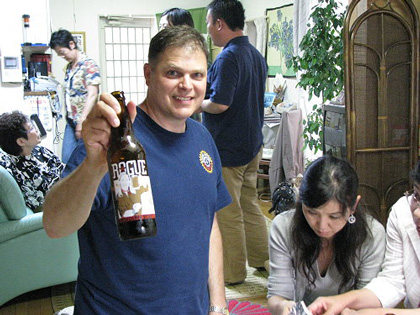
I explained, as those who spoke English translated, that we would sample small quantities of the beers with and without food and then discuss how they taste and if we like them or not. Seemed simple enough and the Japanese, as a culture, are well versed in the art of food and beverage evaluation.
The beers I’d brought were: Rogue Dead Guy Ale, Ninkasi Tricerihops, Rogue Hazelnut Brown Nectar, Alaskan Smoked Porter, Rogue Chocolate Stout, Tracktown Honey Orange Wheat, and Rogue Brewer’s Ale. I know what you’re thinking. I went a little heavy on the Rogue. During the selection process I chose beers that I felt would be more interesting to my audience and the Rogue styles seemed to jump out at me. Also, Rogue is available in the Tokyo area so they could buy more if they liked it.
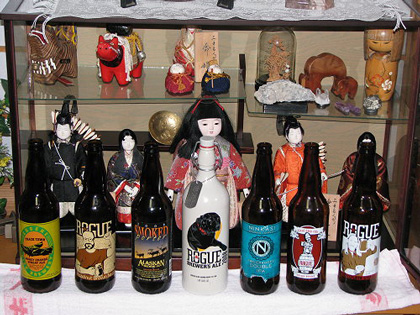
Japan, more so than anywhere I’ve ever been, is a food culture and the Japanese seem keen on trying and evaluating anything and everything. Japanese travel agencies use food and beverage as one of the main engines of international travel. Whereas America is famous for food consumption, Japan is famous for savoring and evaluating each and every element of the meal. Watch one day of Japanese television and you’ll get an idea of how prevalent matters of the palette are.
My research says TV food shows account for an estimated 35 to 40 percent of domestic programming. Talk shows seem to take up a large chunk of the rest and those programs all seem to have a cooking segment or fieldtrip segment, where someone goes somewhere to eat or drink something specialized to a region. After showing all aspects of preparation, the camera goes into a close up and they make the food look extra delicious, giving whatever is being consumed a big jiggle and then following it from plate to mouth after which the taster exclaims, “Oishii desu!” Delicious!
One of these shows was on when a familiar face filled the screen. Harrison Ford was on a TV show plugging his new Indiana Jones movie. After they talked about the movie Harrison had to judge a cook off where 3 sets of chefs prepared special entrees and Mr. Ford had to taste each one, comment on the dish, then choose his favorite. I’ve never seen Harrison Ford more uncomfortable and out of his element as he tasted each dish, but he handled it like a pro. The camera zoomed in and followed the food to his mouth and we all held our breath as he chewed and chewed. His face didn’t betray anything. He could have just as easily been gumming creamed corn. He could use a couple “Ummmm, Ahhhhh†lessons in Japanese food tasting etiquette. Finally he was able to clear his mouth and exclaim “Oishii desu!†Way to go Harry, you pass.
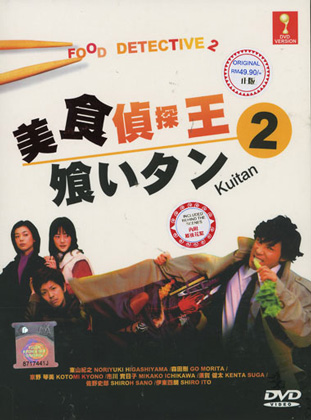
Japan’s obsession with food even crosses lines into other TV genre’s. There’s a Japanese TV mystery drama series called Food Detective 2 (Kuitan 2), where the “Big-Eating†division of the “Holmes Detective Agency” lead by detective Seiya Takano, finds food somehow plays a part in solving every case! Think “Monk†with food rather than OCD. I think you get the picture…let’s get back to the beer.
Though Japanese Craft Beer has made great strides in the new millennium they capture a very small percentage of the overall market share. Most Japanese drink the mainstream lagers and happoshu produced by the big breweries Asahi, Kirin, Sapporo, and Suntory. This would be the first time most of the people in the room had ever tasted craft beer.
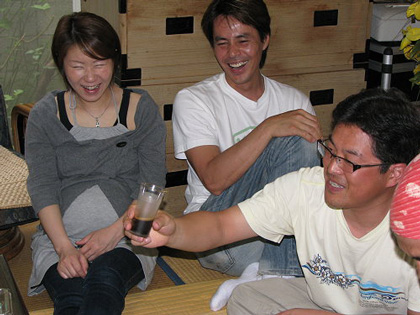
I decided to start light and move gently towards the stronger, more complex beers. The first beer sampled, Tracktown’s Honey Orange Wheat, from Eugene City Brewery where I live. The beer delighted the group and there was a lot of chatter about its soft sweetness, the general consensus, “Oishii desu!â€.
Rogue Hazelnut Brown Nectar met with a similar reaction. It was the introduction of the Rogue Chocolate Stout that the group started to splinter, some finding the chocolate sweetness behind the slightly bitter finish, others blanched at the tasted malt. The Alaskan Smoked Porter, one of my personal favorites was unanimously rejected; they did not like the smoked flavor.
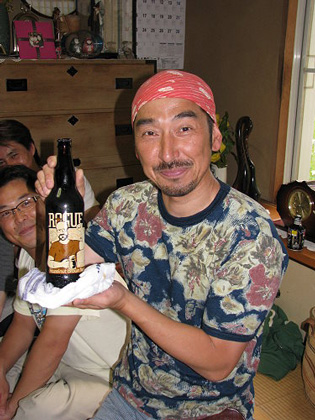
I followed up with another favorite of mine, Rogue Dead Guy Ale, a german-style maibock. A good 90 percent of the group said they liked it very much and they especially liked the Dead Guy Logo. I took a deep breath as my niece, Minami, made the rounds and rinsed our glasses. I had two beers left, Ninkasi Tricerihops, a double IPA and a great example of Northwest hopitude, and Rogue Brewer’s Ale, a strong ale with tons of hop flavor and a huge malt backbone.
“These people aren’t ready for this.†I thought as I filled the glasses and passed them around. I was right, I didn’t even have to ask, the scrunched up faces told the story. Though a few finished their Brewer’s Ale, they all rejected the over-the-top hoppiness we take in stride here in the Northwest.
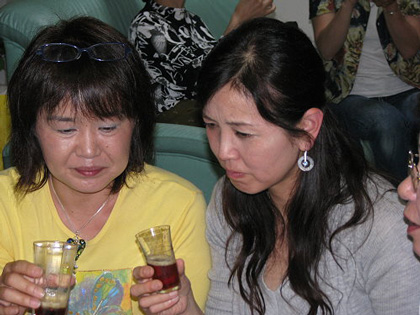
How the beers ranked in taste with my non-craft beer savvy group – Honey Orange Wheat got the big “Oishii desu!†award, followed closely by Hazelnut Brown Nectar, Dead Guy Ale, Chocolate Stout, Smoked Porter, Brewer’s Ale, and Tricerihops.
My results indicate, and this is a very small sampling and not even on speaking terms with anything scientific in nature, that for now Wheat’s, Sweets, and Session beers would be my choice for winning Japanese consumers over to craft beer. I suspect, just like most people who choose the craft beer path, their tastes will develop over time and before you know it they’ll be clamoring for the bigger, more complex offerings we enjoy here in the Good old US of A. As long as there’s some left for me I’m all for it.
To see more pictures of our American Beer Tasting in Japan click link below.
Looking at American Craft Beer with a Japanese Tongue
Illinois Governor Declares July 10 “Beer Distributor Day”
Illinos Governor Rd Blagojevich signed a proclamation today declaring July 10, 2008 to be “Beer Distributor Day,†“commemorating the efforts of beer distributors small and large who have worked in cooperation with the state to regulate the sale and distribution of alcohol for more than 75 years.”
From the press release:
“This proclamation by the governor honors and recognizes all of the hard work that beer distributors have delivered for over 75 years to keep the marketplace fair and competitive for business, good for the economy and safe for the consumer,†said Bill Olson, president of the Associated Beer Distributors of Illinois. “We commend the Governor for his unwavering commitment to Illinois businesses and maintaining a safe marketplace for consumers.â€
Multiple Therapists At Beer Therapy
As many of you probably know, Stan Hieronymus, who’s been dishing out the beer therapy here for many a moon, is on the road. Stan and his wife, Daria Labinsky, along with their daughter, Sierra, are currently on a 15-month trip around the world. You can follow their exploits on The Slow Travelers, a running blog written by the entire family. Stan will continue to post the occasional story here at Beer Therapy, but there will be times when he’s out of range for internet access and times when he’s just too darn busy having fun.
So I’ll be filling in for Stan and taking over the day to day duties of Beer Therapy. I’ll continue to write at my own blog, the Brookston Beer Bulletin, too, and I encourage you to read both. Beer Therapy will remain the place to go for news about the world of beer, whereas I’ll continue to analyze that news on the Bulletin.
Jay Brooks
Welcome to Popeye Beer Club
Posted by By Banjo Bandolas
When the subjects of Beer and Japan cross paths, a discussion about Tokyo’s infamous Popeye Beer Club isn’t far behind. I’d heard the stories about Popeye’s for years. Every time I came back from a family visit to Japan someone would ask “Did you make it up to Popeye’s?â€
Since my wife and I were in Kawasaki to celebrate her birthday with her twin, I figured it was the perfect opportunity to finally make the pilgrimage to the heart of Tokyo and experience Popeye Beer Club for myself.
The trip from Kawasaki station to Tokyo’s Sumida-ku station in Ryogoku would take about an hour each way on one of Tokyo’s infamous commuter trains but what the heck, how often does a guy get to go to a world famous beer bar?
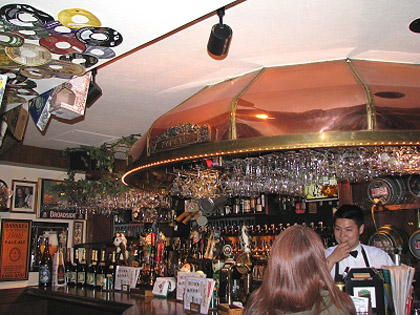
A little history on Popeye’s (pictured above) and the Japanese craft beer industry. Waaaaay back in 1994, when the Japanese government lowered the legal limit for a brewing license from 530,000 to about 16,000 gallons a year the Japanese craft beer movement was born.
A small restaurant owner, Tatsuo Aoki, saw the writing on the wall and wasted no time in learning all he could about craft beer, soon he began offering samples to customers at his small Western-style “snack pub†called Popeye Beer Cub.
The Japanese are by nature an openly curious people, especially when it comes to food or drink, and demand for the new craft beer styles surged. Aoki soon had to remodel to accommodate more customers and expand the number of taps to keep pace with Japan’s growing craft beer industry. Forward thinking, and enthusiasm for craft beer, has made Popeye Beer Club Tokyo’s best pub for Japanese craft beer and “clubhouse†for local and visiting beer geeks.
Cold rain fell as our motley little crew gathered under umbrellas at the Tokyo Edo Museum. The group consisted of me, my wife, Bonne, her sisters Mayumi and Rieme, and Rieme’s husband Kaname. Later we expected to be joined by local beer writer and official expert on Japanese craft beer, Bryan Harrell of Celebrator magazine and Bento.com at Popeye’s.
We planned to meet Bryan at 8 p.m. but we’d opted to arrive in Ryogoku early (4 p.m.) to avoid the crush of rush hour crowds on the trains. To fill the time we visited the Tokyo Edo Museum and planned to sample the fare at a small brewpub in the area called Beer Station. I’ve always found Japanese addresses confusing and this situation was no different, but it wasn’t just me this time. None of us could find Beer Station’s address, 1-3-20 Yokozuma. It was actually kind of funny watching locals flail around just as lost as I would have been.
We wandered around for quite some time before finally breaking down and asking a security guard at the Sumo Stadium if he knew where it was. He knew all right, the brewpub had closed over a year ago. It began to rain harder as that information sank into our collective consciousness. There was nothing else to do, we turned and made our way to Popeye’s 2 hours early.
For a pub with a worldwide reputation, it wasn’t the flashiest place I’d ever seen. In fact, if I wasn’t looking for it, I probably would have strolled right on by. Walking in I immediately felt at home, the place was reminiscent of a good western style pub. Breweriana, a lot of which came from Oregon, filled the walls and dangled from the ceiling.
The good thing about arriving early was we had our choice of tables. We chose a corner spot with a view of the bar and the deck. When we took our seats we were immediately presented with beer lists and hot towels. The towel was a delicious welcome, coming out of the cold, wet weather, and a great start for what would be a memorable evening.
Turned out it was Happy Hour, (I didn’t even know they had Happy Hour in Japan.) with each beer ordered we’d get a complementary plate of food. (Score!)
Our servers Ayano Ishibashi and Kyohei Makajima, were very knowledgeable about craft beer, and very attentive to our needs. I looked down at the list and immediately knew how the Japanese must feel when they come to one of our high end craft beer pubs.
Ayano and Kyohei were about to earn their wages. Most of the breweries weren’t familiar, and quite a few I couldn’t even pronounce. (Especially after a few pints) Although the website and everything else at Popeye’s screamed 40 beers on tap that wasn’t the case when we arrived…they’d recently expanded their offerings to 70 beers on tap.
It felt a little surreal being surrounded by American breweriana and reading at a beer list that looked so alien. Mayumi waved for my attention and pointed up. My eyes followed her finger and I focused on dozens of bottles hanging from the ceiling over my head, many familiar American craft logos were in the bunch. An Oregon brewer’s guild sign on the wall seemed to reach out to me from across the room, saying “you ain’t in Kansas anymore Dorothy.â€
Our servers were delighted to make recommendations and tell us the stories behind the beers as we studied the menus. There were several American craft beers on the list; Full Sail, Rogue, Sierra Nevada, Fish, and Speakeasy. I also saw tap handles for Great Divide and Mendocino behind the bar. Lindeman’s and several other European brews were there too.
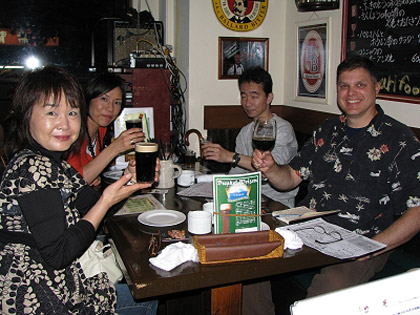
Rogue was the best represented with 6 styles. Not too surprising when you consider Rogue was the first American microbrewery to enter Japan. They began shipping beer to Japan the same year the beer laws changed (1994). Phred Kaufman of Mugishutei (Beer Joint) was instrumental in the successful introduction of Rogue Ales, and the Rogue mystique to Japanese craft beer consumers. It was a match made in beervana, the Japanese appreciate craftsmanship, and they’re willing to pay for it. Rogue punched all the right buttons from labeling their bottles in Japanese Katakana, (the first American craft beer to do so) to choosing styles that matched the Japanese palate Phred Kaufman knew so well.
Interesting, but I didn’t come to Popeye’s to drink American craft beer. I recommended several familiar beers to the group and concentrated on the Japanese offerings. Last time I’d really immersed myself in the Japanese craft beer culture was when I attended the Great Japan Beer Festival in 2001.
That was a turbulent time for the Japanese craft beer industry, not unlike the shakeouts experienced in the American craft brew revolution, where many microbreweries go under due to poor quality, business sense, or just plain bad luck. People in the Japanese craft beer community simply refer to the beginning of the decade as “The Crashâ€. I hadn’t found a lot to get excited about at that 2001 event. Now I was looking forward to evaluating the evolution of Japanese Craft beer since. What I found was a craft beer culture that has grown and matured, carving out a flavor niche that is distinctively Japanese.
The Japanese craft beers I sampled weren’t clones of those from other countries. Sure, they share the names of a wide array of styles we’re all familiar with in American craft beer, but you’ll be hard put to find the bold slap-in-the-face taste common to American microbrews. Whereas big hop taste and high alcohol identify the Northwest beer culture, subtlety and balance seems to be the goal for Japanese microbrewers. I like to savor the interplay of multiple flavors and actually prefer a well balanced beer to many of the over-the-top microbrews.
The bar began to fill up as we received our food and beer. If I closed my eye’s it could be a pub anywhere in the world. (Except eavesdropping on conversations around me was virtually impossible) I watched a mixture of Japanese nationals and foreigners fill the tables. They all had that familiar universal smile I see when people have come to talk about beer.
Riemi, who is very bold in her tastes, selected a Rogue Imperial Stout, a big beer by anyone’s standards. “Whoa!†was about all she could get out initially. I offered to get her a new beer and finish it myself (can’t waste good beer!), but she declined and took another, smaller, sip and smiled “I like it.†Mayumi started with the Hidatakayama Weizen which she really liked and I found very nice as well. She seemed to lean towards the softer weizens, porters, and bocks thru the evening. Kaname was more mainstream in his taste; he tried several styles but ended up going back to pilsner, though he did find a pilsner from Echigo Brewery that he liked much better than the Asahi he usually drinks. Bonne found a new favorite in Swan Lake Golden Ale. I tried a glass. It was the finest golden ale I’ve ever tasted, incredibly clean in taste and clarity; it seemed to glow like liquid sunshine when held up to the light.
We’d already gone thru 15 or so beers and as many plates of food when Bryan Harrell arrived at 8 o’clock. I think he was a little distressed he couldn’t lead me thru the beers, introducing each with a pedigree and brief history on the brewery. I apologized and explained why we’d gotten such an early start on the evening (early by Tokyo standards at least.) But I thought I had a few more in me if he had some suggestions.
“You’ve got to try the Asahi Stout.†he said signaling the server. “It’s a limited draft only release. Popeye’s receives one keg per month and this is the only place in the world you can get it on draft.â€
I tried it and found it to be an excellent, well built, stout.
We discussed some of the other beers I’d already sampled and the state of the Japanese and American craft beer industry. I told him I was very impressed with the advances I saw in the beers since 2001 and I presented him with a bottle of 2008 Rogue Brewer’s Ale I’d brought over to give him. I figured it would be something special he couldn’t get in Japan.
“Hey, they had a keg of this on draft here last month,†he said admiring the bottle, “nice.â€
“Damn, I thought this would be a special treat!â€
“Believe me, it will be. I’ve got some good friends I plan to share this with who will be very impressed.â€
Bryan returned the favor by buying me a bottle of Babakan Catfish Head IIPA (a tongue-in-cheek tribute to Dogfish Head) to take home. I tried a pint and found it very complex and interesting, but using Dogfish Head as a benchmark, it didn’t quite hit the mark. I think I’ll let the bottle age a bit and try it in a year or two, like the Japanese microbrew industry, it’ll only get better with age.
The Japanese Craft Beers we sampled:
Iwatekura – Oyster Stout
Hidatakayama – Weizen
Iwatekura – IPA on cask
Baird – Stout
Minamisinsyu – Winter Ale
Hakusekikan – Dia Brown Ale
Baird – Rising Sun
Isekadoya – Pale Ale
Swan Lake – Golden Ale
Ozenoyukidoke – IPA
Fujizakura Kougen – Dunkle Weizen
Nasukougen – Barley Wine
Ohnuma – Kolsh
Hakusekikan – Pale Ale
Babakan (Catfish Head) – Double IIPA
Echigo – Pilsner
Asahi – Stout
Other organizations that got their start or meet regularly at Popeye’s:
• The Good Beer Club, Japan’s answer to the UK’s Campaign for Real Ale
• Tokyo Real Ale and Nippon Craft Beer festivals began here.
• Members of the Beer Enjoyment, Education and Research Society (BEERS), an English-speaking beer club in Tokyo, are frequent patrons.
Popeye Beer Club
2-18-7 Ryogoku, Sumida-ku
Tokyo, Japan
Phone: 81-3-3633-2120
www.40beersontap.com
Other pubs worth checking out when you’re in Tokyo:
Ushi-Tora Pub
Sankyu Building 2F,
2-9-3 Kitazawa, Setagaya-ku
Tokyo, Japan
http://metropolis.co.jp/tokyo/735/bars.asp
Phone: 81-3-3485-9090
26 beers on tap and a selection of freshly made bar food. It’s on the second story and can be difficult to find, but local shops will help you find it.
Nakameguro Taproom
Nakameguro GT Plaza
C-Block, 2nd Floor, 2-1-3 Kamimeguro
Meguro-ku, Tokyo
Phone: 03-5768-3025
www.bairdbeer.com
Baird Beer Tied House, Twenty taps and four hand-pumps are devoted to the largest lineup of Baird Beer available anywhere.
Northern Japan:
BEER INN MUGISHUTEI
Phred Kaufman’s Beer Joint)
Onda Bldg, B1 S.9W.5 Chuo-Ku
Sapporo, Japan
www.ezo-beer.com
Phone: 512-4774
300 varieties of beer from over 50 countries. The largest selection of beer in the orient.
For a comprehensive source of information on Japanese beer, bars, food, and restaurants go to www.bento.com.
To see more pictures from our visit to Popeye Beer Club go to:
Welcome to Popeye Beer Club
http://www.flickr.com/photos/rogueales/sets/72157605715432793
Duvel buys bankrupted Liefmans Brewery
Duvel Moortgat Brewery has reached an agreement to buy Liefmans Brewery. Both Belgian breweries produce highly praised beers.
Liefmans has been in existence since Jacob Liefmans established his brewery in Oudenaarde in 1770, but the brewery declared bankruptcy and stopped production in late 2007.
Duvel acquired a large portion of the assets of Liefmans, including all the machinery, all brands and recipes. According to a company press release, Duvel will concentrate on Liefmans brown ales and fruit beers brewed in Oudenaarde. Several of the beers have gone back in production and will return to distribution in the near future.
Duvel remains in negotiation for the real estate in Oudenaarde and will invest to revitalize the production site and the well-known visitors’ center when the acquisition is complete. The price of the transaction, including real estate, is 4.5 million euros, or $7.1 million.
Warner resigns as Flying Dog ‘lead dog’
Eric Warner has resigned as “lead dog” at Flying Dog Brewery.
Warner, who served as CEO for eight years, is turning the lead dog position over to Jim Caruso.
“Eight years as CEO is a long time in that position in this or any other industry. I could not be prouder of all that’s been accomplished and I want to make a change while I’m at the top of my game,” Warner said for a company press release. “I would not be comfortable making this move unless there was someone who I felt shared the same passion, enthusiasm, and dedication to Flying Dog that I do and who could seamlessly step in and build on the momentum we’ve created.”
Caruso has been affiliated with Flying Dog since 1995 and has served as the company’s chairman since 1999. “There is no greater joy than being part of the wonderful, wacky and irreverent world of Flying Dog,” Caruso said. “I love beer, and I have extraordinary respect for the talent and dedication of all the people who are the company, and I could not be prouder of what Flying Dog stands for.”
California beer lovers remain on call
The Brewers Association, through its Support Your Local Brewery program, asks California residents to continue to be ready for action.
The message:
Dear Beer Activists and Homebrewers,
Thanks to all of you who took the time to contact the five California Senators on the Governmental Organization Committee to express opposition to A.B. 1245, legislation which would greatly expand the limits on what a brewer can give away to a retailer and so put small brewers at a competitive disadvantage to large brewers.
Unfortunately, the bill passed the committee by a vote of 7-1 and has now moved to the Senate Appropriations Committee. Although it is hard to predict when the Appropriations Committee will consider and vote on the bill, it is likely that this will happen in the next 4-5 weeks. At that time, we will once again send out a call to action and hope you are once again able to make your voice heard in support of California’s small brewers.
For more information contact Tom McCormick.
